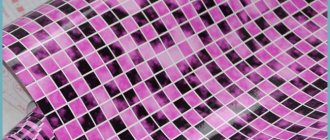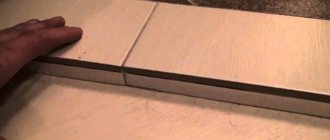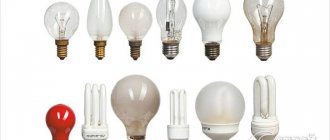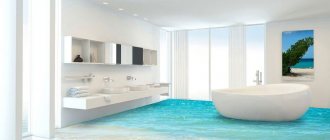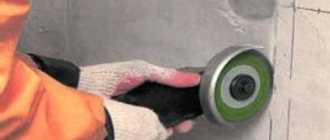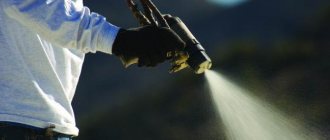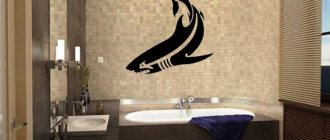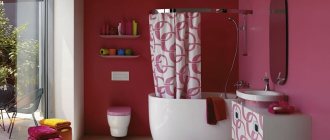Currently, decorative plaster in bathrooms has gained particular popularity.
A wide variety of decorative compositions allows you to decorate the bathroom in different styles, according to any design project.
The coating creates a breathable surface that provides natural air exchange and a comfortable microclimate in the room.
Moisture-resistant decorative plasters are a worthy alternative to tiled cladding and other finishing coatings.
Is it possible to use decorative material to decorate bathroom walls?
Textured plaster for the bathroom is an alternative cladding method compared to the outdated tile sticker.
This option has recently begun to be used in rooms with high humidity. The performance properties of the material allowed the coating to occupy the top positions in the list of decorative finishes for rooms with a similar microclimate. The base layer is selected taking into account the composition of the masonry wall blocks, and the finishing mixture includes coloring substances and elements that form a textured surface.
Advantages of finishing with plaster:
- the impossibility of repeating the pattern even when using the same composition;
- to create a textured surface, a little skill is enough;
- the walls are easy to wash if they get dirty;
- wear-resistant plaster will not lose its appearance during use;
- safety of the mixture, which does not release toxins;
- increased vapor permeability provides the necessary microclimate in the bathroom.
How to properly prepare walls for plastering ↑
Venetian plaster consists of several thin translucent layers of a special mixture, so it is very important to ensure a perfectly even and smooth base for their application. If the partitions in the bathroom have an old coating, then it will have to be dismantled, the surface of the walls should be leveled and sanitizing plaster applied. This leveling and waterproofing base will protect the decorative coating from the moisture of the wall materials, provide waterproofing and prevent cracking of expensive marble finishes.
Ceiling finishing with marble plaster
If you don’t want to remove the old tiles, you can finish the bathroom with moisture-resistant plasterboard using the frame fastening method. The only disadvantage of this method is the loss of usable space, which can be an insurmountable obstacle for small rooms.
Wooden and metal partitions are not suitable for Venetian plaster! There is a high probability that the expensive coating will become covered with cracks.
The surface of the prepared walls must be puttied, then a deep penetration primer is applied and left for 12 hours. After this, apply a layer of covering primer, tinted to match the color of the decorative mixture.
Basics of decorative plaster
The textured design of walls with plaster is inferior in popularity to finishing with porcelain stoneware and tiles. To obtain optimal performance properties of the material, a high-quality mixture is required. When choosing a solution, its composition is taken into account. The main component of plaster coatings is a binding substance, which, when hardened, reliably connects the grains and fibers of the filler, creating a monolithic coating.
Mixtures are divided according to the main component, for example, acrylic or silicone. The second component is the filler, which creates volume and gives the material its main decorative properties. The composition, size and shape of grains and fibers are important.
Various additives give the mixture functional properties, these are:
- increased drying time;
- reduced cracking;
- increasing ductility and fire resistance;
- Mold resistance and color retention.
Silicone
This is an expensive coating that falls into the category of high-quality mixtures. Plaster is characterized by increased performance characteristics, plasticity and lack of electrostaticity. Dust does not settle on surfaces finished with silicone solution. The material has average vapor permeability.
Using the coating, walls are leveled and minor surface defects are hidden. Antiseptic substances are added to the mixture to prevent the appearance of bacteria, fungus and mold.
Mineral
Mineral-based textured plaster is characterized by a low price, increased strength and vapor permeability. The coating includes granite or marble chips. The material is characterized by low ductility, and the finished surface will require painting to create an aesthetic appearance. Strength comes from a Portland cement base. Mineral mortar is used for finishing work on facade surfaces, which indicates resistance to weather conditions.
Polymer
Such solutions contain resins that ensure stable adhesion of the plaster to the base. The coating is insensitive to damage and resistant to deformation and shrinkage. If done correctly at the time of application, the decorative product retains its properties for more than 25 years. The plastic mixture is produced ready to use and does not require dilution with water.
Silicate
This solution is characterized by vapor permeability, elasticity, adhesion with various base options and antiseptic qualities. Allows you to create a high-quality coating that is resistant to various damage during use. The mixture is based on silicates with the addition of antifungal substances. The plaster does not collapse when interacting with water.
What type of bathroom decorations can you choose?
Plaster in the bathroom is often exposed to aggressive influences. In a room where the temperature and humidity levels change, only waterproof finishes are used.
When choosing a coating, you should consider the following nuances:
- Plaster mixtures are produced ready-to-use and dry; they are convenient to work with because they are easy to dilute to the required consistency.
- Applying a composition with large-sized decorative elements requires experience in wall cladding or the involvement of a professional.
- Water-based decorative coating is not suitable for the bathroom. The plastered surface will not be able to resist external damage without waxing, and when applying varnish, vapor permeability will disappear.
Decorating a bathroom with decorative plaster depends on the personal preferences of the owner.
Flock, stone and mosaic compositions are not suitable for wall decoration. It is also better to refrain from covering bark beetles, because the grooves create conditions for mold to appear.
Textured, thin-layer and structural coatings that do not reduce space and are easy to clean correspond to a humid microclimate.
Textured
This type of plaster is suitable for rooms with an unfavorable microclimate: high humidity and changes in temperature. The cladding is resistant to aggressive elements and mechanical stress.
It is a multicomponent composition that contains:
- natural fibers;
- stone particles;
- mineral chips.
The fillers included in plaster help create different textures. A relief surface is obtained after applying the composition.
Venetian
This mixture is distinguished by its decorative and performance qualities. The composition includes slaked lime, the base is supplemented with acrylic resins, pigments and mineral particles. Marble inclusions in the material provide an imitation of natural stone. Microcalcite in the plaster is replaced with quartz or granite dust.
Venetian cladding looks impressive on walls, visually expands the space of bathrooms and gives additional depth. Imitations of light yellow onyx look warm. After drying, it is recommended to cover the multi-layer coating with wax.
Structural
This plaster should not create a strong volume indoors. The “wet silk” coating, which is applied in a thin layer, looks interesting. Imitation of patina on travertine masonry will suit the design of a spacious bathroom with copper fixtures and antique furniture.
Sanitizing
The composition creates a waterproofing layer and prevents the release of sulfate and other salts. This quality distinguishes the mixture from other cement-sand based plasters.
The protective effect manifests itself as follows:
- moisture from the load-bearing wall is directed to the porous layer, in which sulfate salts are retained;
- the liquid is removed through micropores of the second composition;
- The last layer of plaster dries and creates a film that limits the penetration of moisture into the room.
This type of cladding levels the surface and forms a decorative coating. Suitable for bathrooms and toilets. The plaster consists of several components: first a layer of base primer is applied, the next is a sanitizing layer, on top of which the finishing composition is applied. The room can be decorated in any style and color. There is no need to coat the walls with varnishes or additional mixtures.
Facade
This type of plaster is rarely used when renovating a bathroom. The rough structure of the coating is only suitable for some interior styles. The compositions are used for the design of external facades, and not internal ceilings.
The advantages of the mixture include:
- high strength - the decorative finish will not be damaged as a result of mechanical stress;
- long service life of the material - will allow you to maintain the finish until a new renovation;
- Possibility of use outdoors - moisture-resistant plaster can easily withstand the effects of steam, drops of water and elevated temperatures.
Plaster
The main binder in this plaster does not tolerate use in humid microclimates. This is a possible, but not the best option for finishing work in the bathroom. The environmentally friendly material is used to decorate interior walls that require leveling. The solution is applied without prior puttying in a thick layer. The presence of special additives in gypsum plaster ensures adhesion to any substrate. It is recommended to use it as a starting coating, on top of which a decorative layer is applied.
Cement
Plaster based on this material creates a strong, durable layer that is insensitive to high humidity, temperature changes, and mechanical stress. A composition that contains binders and antiseptic additives is suitable for bathrooms.
Moroccan plaster in the bathroom
This type of plaster is rarely used for wall cladding in bathrooms. In the East, where the coating appeared, the mixture was used for interior decoration of palaces. The coating was applied to surfaces that were often in contact with water. The plaster is suitable for finishing cladding of sanitary rooms. The classic application technique is labor-intensive and expensive, but the luxurious and unusual design is worth the investment.
The main advantages of using decorative materials for bathrooms
There are various types of cladding for rooms with high humidity. The working properties of plaster depend on the components included in the composition.
The advantages of decoration for bathrooms and toilets include:
- Increased resistance to moisture penetration. The coating does not allow or absorb water, unlike tiles and plastic cladding. No streaks or stains appear on the plaster.
- Lack of conditions for the spread of bacteria. Even with poor ventilation, fungus and mold do not form on the walls.
- Possibility of applying plaster to uneven surfaces. The base layer hides minor wall defects well.
- Many different textures. This facilitates the use of the mixture as a finishing coating.
- Increased adhesion strength to any wall material. Allows you to apply the composition to any base - concrete, brick or gas blocks.
- Economical consumption of the base mixture, except for the textured coating. Some finishing options require the use of a large amount of material.
- Possibility of applying paint, wallpaper or tiles to a plastered surface.
- Easy to use thanks to adhesion to the substrate, quick drying and no cracking.
- Practicality. The plastered wall is easy to clean using special products.
- Original design. Depending on the composition, you can create a unique textured surface.
- Strength. The textured coating is resistant to various mechanical influences.
If the application and operation technology is followed, the service life of a plastered surface is tens of years.
How to properly apply decorative plaster with your own hands in the bathroom
To finish the surface in the bathroom, leveling the surface is not required; minor defects are allowed when plastering, but the consumption of the decorative mixture will increase. It will be cheaper to approach the leveling stage of work responsibly.
The quality of the decorative coating depends on:
- from exact execution of instructions;
- from surface pretreatment.
When preparing a room for work, it is necessary to take into account nuances, including:
- compliance with the temperature regime (minimum - +5°C, maximum - +35°C);
- humidity - up to 60%;
- eliminating drafts;
- de-energization of wiring.
Ready-made solutions have a service life. It is recommended to dilute the mixture in the required quantity so that there is no waste of material.
Preparation
Before plastering the surface, pre-treatment is required, which includes the following steps:
- Removing irregularities. Dents and cracks on the walls are thoroughly cleaned of old putty, covered with cement and washed. For better adhesion of the mixture to the surface, the seams of the brickwork are drilled to a depth of 0.5 cm.
- Notches are formed on a smooth surface, after which the base is primed with a solution with antiseptic additives.
- In large rooms, guides are installed, which are secured with gypsum material.
Application
A spray is applied to the pre-wetted surface. The composition is applied to the wall by throwing a layer 5-9 mm thick. After the solution has set, a base mixture is prepared, which has the consistency of a thick dough. For this purpose, cement and sand are mixed in a ratio of 1:3. The base is applied to the previous layer and leveled with a metal rule. Movements are made from bottom to top. The beacons are removed after the rough layer has dried. The remaining dents are filled with solution and leveled with a spatula.
The final stage of finishing with decorative plaster
Work on applying the finishing coating begins only after the rough layer has partially hardened, which is moistened with water when hardening. The thickness of the solution is 4-7 mm.
The application technique varies depending on the type of building material:
- Smooth surfaces. Using a narrow spatula, the solution is applied to a larger tool, which is held at an angle of 20°, distributing the mixture over the surface. The work is done with slow movements. The corners are finished with a spatula in a horizontal direction. The protruding areas are carefully leveled with a float after the layer has set.
- Textured surface. The main tool used in the work is a narrow spatula. The direction of movement depends on the coating application option.
Moisture-resistant decorative plasters are coated with varnishes and paints, which create a waterproof film on the surface. For decorating wet rooms, dyes with a silicone or acrylic base are considered suitable. Paint and varnish solutions are applied to the surface after the plaster layer has dried. There are several techniques for applying paint: 1 or 2 layers of different colors.
Coating care
Since the decorative plaster is coated with acrylic varnish on top, its surface is easily cleaned with water. It is also allowed to use any liquid detergents. The elastic structure of the material prevents the appearance of cracks; if the surface is not specifically hit with a hammer, chips will not appear on it. But when any other defects suddenly appear, they are easily hidden by painting. The presence of fungicides prevents the appearance of mold. Therefore, maintenance comes down to simply wiping the walls from dust with a damp cloth once a week.
Bathroom care tools Source etalonk.com
Moisture-resistant decorative plasters, manufacturers and features
The finishing materials market offers a wide range of mixtures for decorating bathroom walls. They are often guided by the name of the manufacturer.
Coating lines from popular brands differ in various properties:
- Among the mineral plasters, the gypsum textured mixture Rotband, produced by the Grundband company, stands out. The composition is characterized by increased ductility, increased adhesion and rapid strength gain. The material is applied in a layer of up to 5 cm and is used for finishing bathrooms and bathrooms.
- Acrylic plaster Kratzputz D227 from Dufa, which gives the surface an orange peel effect, has received positive reviews. The coating is characterized by increased strength, vapor permeability and increased adhesion.
- Stuc granito and deco are a composition based on cement-polymer plaster from the Marcel company. The coating reaches a thickness of 3 mm or more when applied in 2-3 layers. Characterized by increased moisture-resistant properties.
- The Russian mixture Rodnik-Art and Turkish plaster Silcoat contain silk fibers as a filler.
Recommendations for selection
When choosing facade plaster, you need to make sure that the material has environmental properties and that there are no chemical compounds that can cause harm during operation.
When decorating walls, special attention should be paid to the harmlessness of the material.
All materials for bathroom renovations must be moisture resistant. This condition will help avoid the following negative consequences:
- peeling;
- black spots;
- bubbles.
The type of finishing material affects the duration of the work. If there are no time restrictions, you can use cement-based plaster.
All materials for finishing the bathroom must have high moisture resistance.
Gypsum mixtures are available in well-ventilated areas. In the future, they can be tiled or decorated.
For speedy design, it is better to select acrylic compositions that dry quickly. Rough terrain with grooves requires the use of a composition with hard granules. A uniform roughness can be achieved using a soft sponge.
For decoration, use a plastic spatula, roller or sponge.
After covering with the finishing layer, use of the bathroom is prohibited for 2-3 days.
Finishing materials are durable, so it is necessary to take into account possible changes in the interior associated with updating plumbing and adding missing elements in the future.

